 Kapurthala is one of the popular cities of the state of Punjab and is also the administrative and secretarial headquarters of Kapurthala district. The capital of a former Sikh state, Kapurthala is located 19 km from Jalandhar, another famous city of Punjab. It has been the chief town of the Ahluwalia family since the conquest and consolidation of various scattered possessions. In spite of an early alliance with the British in the year 1809, Kapurthala troops fought bravely against the British at Aliwal during the First Sikh War. Later on, the subsequent ruler turned Kapurthala into a model city-state. In this city, there are several splendid monuments including its prominent buildings that reflect French and Indo-Saracenic style of architecture and self narrate the secular and aesthetic combination of the city`s rich princely past.
Kapurthala is one of the popular cities of the state of Punjab and is also the administrative and secretarial headquarters of Kapurthala district. The capital of a former Sikh state, Kapurthala is located 19 km from Jalandhar, another famous city of Punjab. It has been the chief town of the Ahluwalia family since the conquest and consolidation of various scattered possessions. In spite of an early alliance with the British in the year 1809, Kapurthala troops fought bravely against the British at Aliwal during the First Sikh War. Later on, the subsequent ruler turned Kapurthala into a model city-state. In this city, there are several splendid monuments including its prominent buildings that reflect French and Indo-Saracenic style of architecture and self narrate the secular and aesthetic combination of the city`s rich princely past.
The most magnificent monuments date from the time of Jagatjit Singh, who ascended the throne in the year 1890. He was an enthusiastic Francophile and on his accession turned the city into "a scrap of Paris laid at the foot of the Himalayas". The `Sainik School` of Kapurthala is one of its most popular monuments and it was formerly known as Jagatjit Palace. The credit of designing the magnificent architecture of this palace goes to renowned French architect M. Marcel. Its construction started in the year 1900 and was completed in the year 1908. In the year 1862 Kanwar Bikrama Singh built the Elysee Palace or Jalaukhana. It has been changed into a boy`s school now. This magnificent building with its imposing and elegant facade has now been converted into MGN School of Kapurthala. The palace comprises a central bay, cribbed from Fontainebleau, with a high pavilion roof and windows that are flanked by two symmetrical wings with blind arcades terminated by secondary pavilions. The interior is treated lavishly in the same opulent French manner, with Louis XIV furniture, enriched plasterwork, fine marble chimney pieces and Aubusson carpets specially woven for the rooms. The gardens are embellished with fountains and statuary in complete French manner and the entire area is designed is such a way that it resemble a French estate. The surrounding buildings are designed in other European styles.
Moorish Mosque is another most spectacular monument of Kapurthala. It is popularly called as the replica of Morocco`s Grand Mosque of Marakesh. It was also designed by a French architect Monsieur M. Manteaux. It took 13 long years for the completion of this lavish building. Maharajah Jagatjit Singh who was the last ruler of Kapurthala commissioned its foundation. It contains attractive decorations collected from the Mayo School of Art in Lahore. Archaeological Survey of India has given it the status of a National Monument of the country. Located in the heart of the city is Jagatjit Club, an elegant Greek revival style of building. Since its construction, it has been used for several purposes like as a church, cinema hall and presently it has become a local club. Some more popular heritages of this city include Shalimar Gardens, Panch Mandir (Five Temples), which is the place worship for people of all faiths and religions. This temple has five small spectacular temples. The State Gurudwara is another popular monument of this city and it was constructed in a proper Indo-Saracenic style.
Kapurthala is popular for its several monuments and heritage sites that wonderfully express its rich history.



















